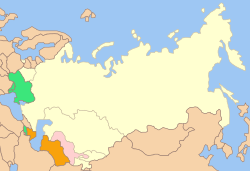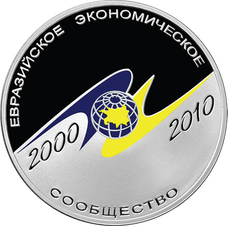- Eurasian Economic Community
-
Евразийское экономическое сообщество
Eurasian Economic Community
Headquarters Almaty, Minsk, Moscow, Saint Petersburg Membership 6 states Leaders - Secretary General Tair Mansurov Establishment - Customs union 29 March 1996 - OCAC merger 25 January 2006 Website
evrazes.comThe Eurasian Economic Community (EAEC or EurAsEC) originated from the Commonwealth of Independent States (CIS) customs union between Belarus, Russia and Kazakhstan on 29 March 1996.[1] The Treaty on the establishment of the Eurasian Economic Community was signed on 10 October 2000,[2] in Kazakhstan's capital Astana by Presidents Alexander Lukashenko of Belarus, Nursultan Nazarbayev of Kazakhstan, Askar Akayev of Kyrgyzstan, Vladimir Putin of Russia, and Emomali Rakhmonov of Tajikistan. On 7 October 2005 it was decided between the member states that Uzbekistan would join. Freedom of movement is implemented among the members (no visa requirements).[3] Common Economic Space was launched on 1 January 2010.[4]
Contents
Membership
Members
 Belarus
Belarus Kazakhstan
Kazakhstan Kyrgyzstan
Kyrgyzstan Russia
Russia Tajikistan
Tajikistan Uzbekistan (suspended)[5]
Uzbekistan (suspended)[5]
Observers
Organization of Central Asian Cooperation
The Organization of Central Asian Cooperation (OCAC) (Central Asian Cooperation Organization, CACO, Russian: Центрально-Азиатское сотрудничество, ЦАС) was an international organization, composed of Kazakhstan, Kyrgyzstan, Tajikistan, Uzbekistan and Russia. Georgia and Ukraine had observer status. Kazakhstan, Kyrgyzstan, Tajikistan, Turkmenistan and Uzbekistan formed the OCAC in 1991 as Central Asian Commonwealth (CAC). The organization continued in 1994 as Central Asian Economic Union (CAEU), in which Tajikistan and Turkmenistan did not participate. In 1998 it became Central Asian Economic Cooperation (CAEC), which marked the return of Tajikistan.[6]
On 28 February 2002, it was renamed to its current name. Russia joined on 28 May 2004.[7] On 7 September 2005, at the St. Petersburg Summit of the Central Asian Cooperation Organization, it was agreed to merge CACO into EurAsEC.
In October 2005, Uzbekistan applied for membership in EAEC.[8] OCAC has de facto dissolved on 25 January 2006, when Uzbekistan joined EAEC.[9] But later in 2008 Uzbekistan has decided to temporarily suspend its membership.[5]
Aims
EAEC was established for effective promotion of the creation by the Customs Union member states of a Single Economic Space and for coordinating their approaches while integrating into the world economy and the international trade system. One of the Organization's chief activity vectors is ensuring the dynamic evolution of the Community states through coordinating their economic and social reforms while effectively using their economic potentials to improve the living standards of their peoples. Among the principal tasks of the Community are:
- completing the formalization of a free trade regime in all respects, creating a unified customs tariff and a unified system of nontariff regulation measures;
- laying down the common rules for trade in goods and services and their access to internal markets;
- introducing a unified procedure for foreign exchange controls;
- creating a common unified system of customs regulation;
- drawing up and implementing joint programs of economic and social development;
- creating equal conditions for production and entrepreneurial activities;
- forming a common market for transportation services and a unified transport system;
- forming a common energy market;
- creating equal conditions for access by foreign investment to the sides' markets;
- giving the citizens of the Community states equal rights in receiving education and medical assistance throughout its territory;
- converging and harmonizing national legislation;
- ensuring the coordination of the legal systems of the EAEC states with a view to creating a common legal space within the Community.
Institutional framework
- Interstate Council
- Integration Committee
- Energy Policy Council
- Transport Policy Council
- Council on Border Issues
- Council of Heads of Customs Services
- Council of Heads of Tax Services
- Council of Ministers of Justice
- Secretariat
- Commission of Permanent Representatives
- Interparliamentary Assembly
- Community's Court of Justice
Economic data
Country Population GDP 2006 (USD) GDP 2007 (USD) growth per capita Belarus 9,688,796 36,961,815,474 44,773,406,221 21.13% 4,621 Russia 142,498,534 984,926,789,696 1,289,582,151,445 30.93% 9,050 Kazakhstan 15,421,864 81,003,864,916 104,143,432,632 28.57% 6,753 Kyrgyzstan 5,316,544 2,834,168,893 3,745,000,489 32.14% 704 Uzbekistan 27,372,256 17,077,480,575 19,274,619,012 12.87% 704 Tajikistan 6,735,996 2,830,213,563 3,737,572,699 32.06% 555 EAEC total 207,033,990 1,125,634,333,117 1,465,256,182,498 30.17% 7,077 Common Economic Space
See also: Common marketAfter discussion about the creation of a common economic space between the CIS countries of Russia, Ukraine, Belarus, and Kazakhstan, agreement in principle about the creation of this space was announced after a meeting in the Moscow suburb of Novo-Ogarevo on 23 February 2003. The Common Economic Space would involve a supranational commission on trade and tariffs that would be based in Kiev, would initially be headed by a representative of Kazakhstan, and would not be subordinate to the governments of the four nations. The ultimate goal would be a regional organisation that would be open for other countries to join as well, and could eventually lead even to a single currency. On 22 May 2003 The Verkhovna Rada (the Ukrainian Parliament) voted 266 votes in favour and 51 against the joint economic space. However, Viktor Yushchenko's victory in the Ukrainian presidential election of 2004 was a significant blow against the project: Yushchenko had shown renewed interest in Ukrainian membership in the European Union, and such membership would have been incompatible with the envisioned common economic space. On March 1, 2010 the first deputy head of the presidential administration of newly elected Ukrainian President Viktor Yanukovych, Iryna Akymova stated that Ukraine does not intend to join the Customs Union of Russia, Kazakhstan and Belarus in the near future "Since the customs union contradicts and will greatly complicate Ukraine's membership in the WTO".[10]
A single market for the Customs Union of Belarus, Kazakhstan and Russia is envisioned for 2012.[11] It is expected that Serbia and Montenegro will join in the future as well.[12]
EurAsEC Customs Union
The EurAsEC Customs Union became a top priority since Spring 2008, when the EU announced its Eastern Partnership. Since that time, there has been discord between the EU and Russia with both sides accusing the other of attempting to carve out spheres of influence over the countries at issue (Belarus, Armenia, Azerbaijan, Georgia, Moldova and Ukraine). A supranational body of the customs union—the EurAsEC Customs Union Commission--was established on December 12, 2008. Boiled down to its essence, Russia has offered EurAsEC members access to its markets (i.e., for Kazakhstan) and lower energy prices (i.e., Belarus, Ukraine). The EU's offer to membership countries amounts to promises of de facto EU integration, such as relaxed visa entry requirements.
The Customs Union members—Kazakhstan, Belarus and Russia—reached an agreement on a unified customs tariff in June 2009 and endorsed a schedule for creating a unified customs territory.
According to Russian President Dmitry Medvedev the creation of a common economic space for Russia, Kazakhstan, and Belarus may be launched on 1 January 2010.[4][13] Russian Foreign Minister Sergei Lavrov said on 10 December 2008 that Moscow is ready to build a common economic space with both Europe and the United States if every party is treated equally.[14] According to reports from April 2010, the new Customs Union is intended to go into effect on July 1, 2010.[15]
The Russian, Kazakh, and Belarusian leaders have approved documents to establish a “common economic space” on 1 January 2012 – a single market for goods, investment, and labor.[16]
Kazakh President Nursultan Nazarbayev has proposed the creation of a common noncash currency called yevraz for the community. This would help insulate the countries from the global economic crisis.[17]
See also
- Comecon, Soviet-era economic integration plan.
- OSCE countries statistics
- Regional organizations in the Post-Soviet space
International trade Terminology Absolute advantage · Balance of payments · Balance of trade · Capital account · Comparative advantage · Current account · Export-oriented industrialization · Fair trade · Foreign exchange reserves · Globalization · Import substitution industrialization · Net capital outflow · Outsourcing · Trade justice · Trading nationOrganizations and policies Schools of thought Customs unions Trading partners Central Asian regional organizations Central Asia plus Japan · Central Asia Regional Economic Cooperation Program · Commonwealth of Independent States (Collective Security Treaty Organisation and Eurasian Economic Community) · Economic Cooperation Organization · Shanghai Cooperation Organisation · Turkic CouncilReferences
- ^ WTO WT/REG71/1
- ^ Foundation Agreement of EAEC
- ^ Могут ли граждане стран, входящих в ЕврАзЭс, свободно перемещаться по территории Сообщества? (Russian)
- ^ a b Russia, Kazakhstan, Belarus plan on common economic space
- ^ a b Uzbekistan suspends Eurasec membership, Moscow unruffled
- ^ Collective Security: A Timeline
- ^ Central Asian Cooperation Organization
- ^ Working group discusses Uzbekistan's accession to EAEC
- ^ Uzbekistan becomes official member of Eurasian Economic Community
- ^ Presidential administration official: Ukraine not to join customs union, Kyiv Post (March 1, 2010)
- ^ Russia expects CIS countries to create free trade area
- ^ http://www.b92.net/eng/news/region-article.php?yyyy=2011&mm=10&dd=20&nav_id=76945
- ^ http://en.rian.ru/world/20091127/157010984.html
- ^ Lavrov wants [European Union–Russia Common Spaces common economic space with Europe, US
- ^ http://www.tsouz.ru/Pages/Default.aspx
- ^ Kenjali Tinibai, Economy & Business: A Semi-Soviet Union is Born, TRANSITIONS ONLINE (March 9, 2010) available at www.ceeol.com
- ^ Moscow times: Kazakhstan Suggests a New Currency
Categories:- Commonwealth of Independent States
- Post-Soviet alliances
- Eurasia
- Federalism
- Multiregional international organizations
- Trade blocs
- 1996 establishments
- United Nations General Assembly observers
- Multilateral relations of Russia
- Belarus–Russia relations
- Kazakhstan–Russia relations
- Kyrgyzstan–Russia relations
- Russia–Tajikistan relations
- Russia–Uzbekistan relations
- Kyrgyzstan–Uzbekistan relations
- Kyrgyzstan–Tajikistan relations
- Tajikistan–Uzbekistan relations
- Kazakhstan–Kyrgyzstan relations
- Kazakhstan–Uzbekistan relations
Wikimedia Foundation. 2010.



